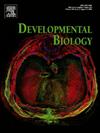Keratinization and cornification of avian skin appendages during development. Insights from immunolabeling and electron microscopic studies
IF 2.5
3区 生物学
Q2 DEVELOPMENTAL BIOLOGY
引用次数: 0
Abstract
The basal cytoskeleton of avian keratinocytes consists in a number of Intermediate Filament Keratins (IFKs, also indicated as alpha-keratins), poor (soft) or rich (hard) in cysteine. In keratinocytes of developing skin appendages Corneous Beta Proteins (CBPs, formerly termed beta-keratins), build most of the corneous material of developing scutate scales, claws, beak and feathers. CBPs derive from a gene locus termed Epidermal Differentiation Complex (EDC), unrelated to genes for IFKs. CBPs and IFKs belong to two different gene families that evolved independently during the evolution of birds. The evolution of feathers derived from the initial morphogenesis of barb ridges containing specialized proteins. During feather development, the framework of IFKs that combine with CBPs in differentiating keratinocytes, barb and barbule cells, give rise to resistant but flexible corneocytes in feathers and hard corneocytes in scales, claws and beaks. Here, we mainly deal with avian IFKs that are accumulated during the development of skin derivatives of birds, especially downfeathers. The latter are corneous appendages and, when mature, are composed from a prevalent mass of feather-CBPs (fCBPs, formerly indicated as feather beta-keratins). During development fCBPs are deposited over a IFKs cytoskeleton formed in barb and barbule cells, and these small beta-proteins rapidly overcame in amount IFKs, generating the corneous barbs and barbules of downfeathers. This process likely occurs through electrostatic interactions between acidic IFKs and basic CBPs, and later by the formation of covalent bonds (-S-S- and epsilon-bonds). Proteome and molecular studies have sequenced most of IFKs and CBPs of feathers in some species of birds. Most of the proteins extracted from feathers are fCBPs, while a lower amount is constituted from IFKs and other minor proteins.

求助全文
约1分钟内获得全文
求助全文
来源期刊

Developmental biology
生物-发育生物学
CiteScore
5.30
自引率
3.70%
发文量
182
审稿时长
1.5 months
期刊介绍:
Developmental Biology (DB) publishes original research on mechanisms of development, differentiation, and growth in animals and plants at the molecular, cellular, genetic and evolutionary levels. Areas of particular emphasis include transcriptional control mechanisms, embryonic patterning, cell-cell interactions, growth factors and signal transduction, and regulatory hierarchies in developing plants and animals.
 求助内容:
求助内容: 应助结果提醒方式:
应助结果提醒方式:


